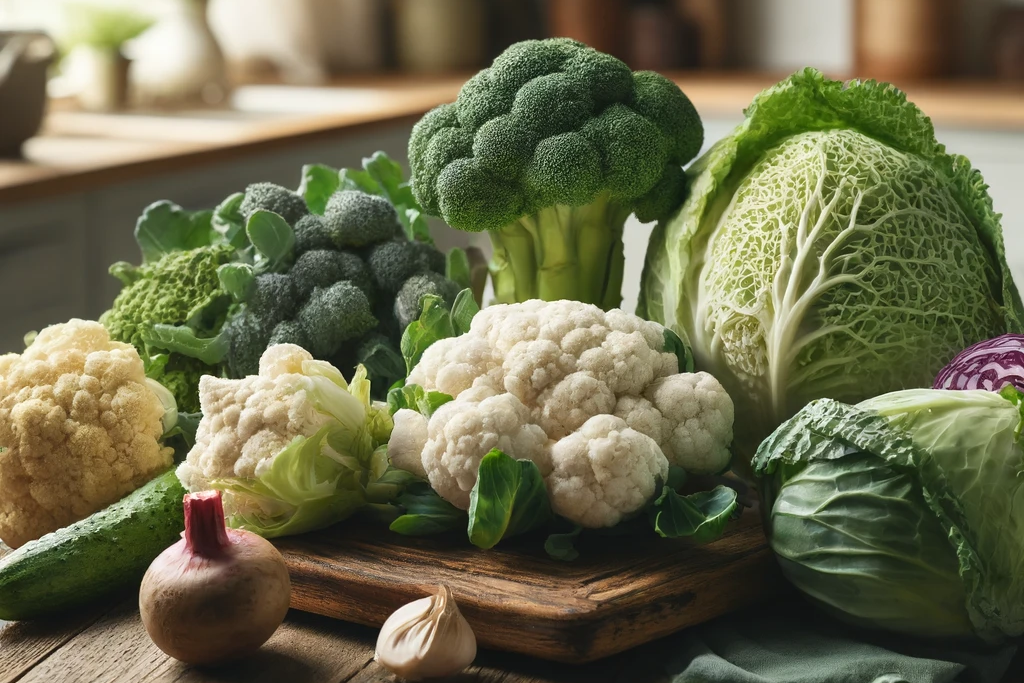Glucosinolates

Glucosinolates are natural plant substances that are mainly found in cruciferous vegetables such as broccoli, cabbage and radish. They have a range of positive and negative effects on human and animal health. In this article you can find out more about glucosinolates and how they can affect dogs.
What are glucosinolates?
Glucosinolates are sulphur- and nitrogen-containing compounds that are formed from amino acids. Their basic structure consists of an N-hydroximinosulfate ester linked to a thioglucose residue and a variable side chain. The side chain determines the chemical properties and biological activity of glucosinolates.
Glucosinolates themselves are odorless and tasteless. Only when they are cleaved by the enzyme myrosinase are the pungent and bitter mustard oils (isothiocyanates) produced, which are responsible for the typical taste of cruciferous vegetables. The breakdown can be triggered by crushing or chewing the plants or by bacteria in the intestine.
What are the benefits of glucosinolates for dogs?
Glucosinolates and their breakdown products have various positive effects on the health of dogs. On the one hand, they can strengthen the immune system and inhibit inflammation. On the other hand, they can slow down or prevent the growth of cancer cells by disrupting their metabolism or causing DNA damage.
Some studies have shown that dogs with cancer respond better to a low-carbohydrate, high-fat diet than to a high-carbohydrate diet. Since cruciferous vegetables are low in carbohydrates but high in glucosinolates, they can be a useful addition to the diet of dogs with tumors.
What are the disadvantages of glucosinolates for dogs?
Glucosinolates are not only beneficial, but can also be harmful. Excessive amounts of glucosinolates or mustard oils can lead to gastrointestinal problems such as diarrhea or vomiting. They can also impair thyroid function by inhibiting iodine uptake or disrupting the production of thyroid hormones.
Dogs with an existing hypothyroidism or a diet low in iodine are particularly at risk. Puppies should also not be given too many cruciferous vegetables, as their thyroid gland is not yet fully developed.
How much cruciferous vegetables can a dog eat?
There is no precise information on how much cruciferous vegetables a dog can tolerate or needs. This depends on various factors such as the dog's age, weight, state of health and individual sensitivity. In general, however, the dose makes the poison.
As a rule of thumb, one to two tablespoons of cooked broccoli per day is safe for a medium-sized dog. Raw broccoli contains more myrosinase than cooked broccoli and should therefore only be fed in small quantities. Other cruciferous vegetables such as cabbage or radishes have similar effects to broccoli, but also similar risks. Cabbage, for example, can cause flatulence or impair thyroid function. It should therefore only be fed cooked and in small quantities.
Glucosinolates are plant substances that can have both advantages and disadvantages for dogs. They can strengthen the immune system and prevent cancer, but can also cause gastrointestinal or thyroid problems. The decisive factors for the effect of glucosinolates on dogs are the quantity and the preparation. If you want to feed your dog cruciferous vegetables, you should observe the following tips:
- Feed only small amounts of cruciferous vegetables (no more than 25% of the diet) and discuss the optimal dosage for your dog with your veterinarian.
- Cook cruciferous vegetables before feeding to reduce myrosinase activity and improve digestibility.
- Avoid raw or fermented cruciferous vegetables as they contain more mustard oils and can be more harmful.
- Monitor your dog after feeding cruciferous vegetables for possible side effects such as diarrhea, vomiting or lethargy and discontinue feeding if necessary.
Cruciferous vegetables can be a healthy addition to your dog's diet if you feed them correctly. They can help your dog stay fit and healthy.
If you notice any signs of hypersensitivity or poisoning in your dog, you should see your vet immediately. We are not a substitute for a vet, but we try to be as accurate as possible. Every dog reacts differently and we recommend you get a second opinion or consult your vet if in doubt.
Stay healthy and take good care of your four-legged friend!😊
Similar to Glucosinolates
Isothiocyanates are natural substances that are formed from glucosinolates, a group of secondary plant substances found in certain vegetables. They are released when the plant is damaged, for...
Indole is a heterocyclic organic molecule characterized by a combination of a benzene ring and a pyrrole ring. It is a natural substance that occurs in many plants and also as a degradation product...
Sulforaphane is a sulphur-containing compound found in cruciferous vegetables such as broccoli, Brussels sprouts and cabbage. It is released by the enzyme myrosinase when the vegetables are chopped...
Phenylethyl isothiocyanate belongs to the group of isothiocyanates, chemical compounds that occur naturally in certain vegetables, particularly cruciferous vegetables such as broccoli, cauliflower,...



